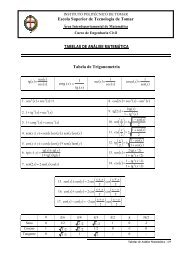Trigonometria Hiperbólica Definimos Co-Seno Hiperbólico de x ...
Trigonometria Hiperbólica Definimos Co-Seno Hiperbólico de x ...
Trigonometria Hiperbólica Definimos Co-Seno Hiperbólico de x ...
You also want an ePaper? Increase the reach of your titles
YUMPU automatically turns print PDFs into web optimized ePapers that Google loves.
<strong>Trigonometria</strong> <strong>Hiperbólica</strong><br />
<strong>Definimos</strong> <strong>Co</strong>-<strong>Seno</strong> <strong>Hiperbólico</strong> <strong>de</strong> x (cosh x),<br />
<strong>Seno</strong> <strong>Hiperbólico</strong> <strong>de</strong> x (sinh x), Tangente<br />
<strong>Hiperbólica</strong> <strong>de</strong> x (tanh x) e <strong>Co</strong>-tangente <strong>Hiperbólica</strong><br />
<strong>de</strong> x (coth x), a partir das seguintes<br />
equações:<br />
cosh x = ex +e −x<br />
2<br />
sinh x = ex−e−x 2 ;<br />
tanh x =<br />
coth x =<br />
;<br />
sinh x<br />
cosh x = e2x −1<br />
e 2x +1 ;<br />
cosh x<br />
sinh x = e2x +1<br />
e 2x −1<br />
= 1<br />
tanh x .<br />
(1)<br />
Note-se que cosh x, sinh x e tanh x são <strong>de</strong>finidas<br />
para qualquer x ∈ mas coth x não é <strong>de</strong>finido<br />
para x = 0.<br />
1
Para obter<br />
cosh 0 = 1 , sinh 0 = 0 , tanh 0 = 0<br />
basta substituir x por 0 nas fórmulas anteriores.<br />
Temos as seguintes consequências da <strong>de</strong>finição:<br />
(i) cosh x > 0, pois e x > 0 para todo x ∈ ;<br />
(ii) | sinh x| < cosh x, pois a soma <strong>de</strong> dois números<br />
positivos é sempre superior à sua diferença;<br />
(iii) | tanh x| =<br />
| sinh x|<br />
cosh x<br />
< 1, para todo x ∈ <br />
2
Temos ainda as seguintes proprieda<strong>de</strong>s.<br />
x = 0 ⇒ cosh x > 1<br />
x < 0 ⇒ sinh x < 0 ∧ tanh x ∈] − 1, 0[<br />
∧ coth x ∈] − ∞, −1[<br />
x > 0 ⇒ sinh x > 0 ∧ tanh x ∈]0, 1[<br />
∧ coth x ∈]1, +∞[<br />
Para obter<br />
cosh(−x) = cosh x , sinh(−x) = − sinh x ,<br />
tanh(−x) = − tanh x , coth(−x) = − coth x<br />
basta substituir x por −x nas fórmulas (1).<br />
3
Iremos agora estabelecer as principais fórmulas<br />
da trigonometria hiperbólica.<br />
cosh x + sinh x = e x<br />
cosh x − sinh x = e −x<br />
cosh 2 x − sinh 2 x = 1<br />
1 − tanh 2 x =<br />
1<br />
cosh 2 x<br />
coth 2 x − 1 = 1<br />
sinh 2 x (2)<br />
4
cosh x =<br />
1<br />
√ 1−tanh 2 x , sinh x =<br />
√ tanh x<br />
1−tanh2 x<br />
(3)<br />
<strong>Co</strong>mo tanh x ∈] − 1, 1[ então 1 − tanh 2 x > 0.<br />
Por outro lado, como cosh x > 0 vem:<br />
√ cosh 2 x = cosh x.<br />
Logo da quarta fórmula <strong>de</strong> (2) vem<br />
<br />
1 − tanh 2 x =<br />
1<br />
cosh x<br />
⇒ cosh x =<br />
<strong>Co</strong>mo sinh x = tanh x cosh x então<br />
sinh x =<br />
tanh x<br />
<br />
1 − tanh 2 x<br />
.<br />
1<br />
<br />
1 − tanh 2 x<br />
5
cosh(x + y) = cosh x cosh y + sinh x sinh y<br />
sinh(x + y) = sinh x cosh y + cosh x sinh y<br />
tanh(x + y) =<br />
coth(x + y) =<br />
tanh x+tanh y<br />
1+tanh x tanh y<br />
1+coth x coth y<br />
coth x+coth y<br />
cosh 2x = cosh2 x + sinh2 x<br />
sinh 2x = 2 sinh x cosh x<br />
(4)<br />
tanh 2x =<br />
2 tanh x<br />
1+tanh2 x<br />
coth 2x = 1+coth2 x<br />
2 coth x (5)<br />
Estas fórmulas obtêm-se das anteriores fazendo<br />
x = y<br />
6
cosh x cosh y = 1 2 (cosh(x + y) + cosh(x − y))<br />
sinh x sinh y = 1 2 (cosh(x + y) − cosh(x − y))<br />
sinh x cosh y = 1 2 (sinh(x + y) + sinh(x − y))<br />
cosh a + cosh b = 2 cosh a+b<br />
cosh a − cosh b = 2 sinh a+b<br />
sinh a + sinh b = 2 sinh a+b<br />
sinh a − sinh b = 2 cosh a+b<br />
2<br />
2<br />
2<br />
2<br />
cosh a−b<br />
2<br />
sinh a−b<br />
2<br />
cosh a−b<br />
(6)<br />
2<br />
sinh<br />
a−b<br />
2 (7)<br />
Estas igualda<strong>de</strong>s obtêm-se das fórmulas anteriores<br />
e <strong>de</strong><br />
cosh x sinh y = 1<br />
(sinh(x + y) − sinh(x − y))<br />
2<br />
fazendo <br />
a = x + y<br />
b = x − y<br />
⇔<br />
<br />
x = a+b<br />
2<br />
x = a−b<br />
2<br />
7
Finalmente iremos estabelecer as chamadas<br />
Fórmulas <strong>de</strong> Moivre<br />
∀m ∈ (cosh x + sinh x) m = cosh mx + sinh mx<br />
∀m ∈ (cosh x − sinh x) m = cosh mx − sinh mx<br />
Para quaisquer x ∈ e m ∈ tem-se por (2)<br />
(cosh x + sinh x) m = (e x ) m = e xm<br />
= cosh mx + sinh mx<br />
(8)<br />
e do mesmo modo se <strong>de</strong>monstrava a segunda<br />
proprieda<strong>de</strong>.<br />
8




